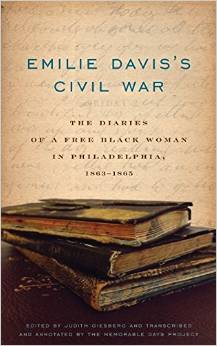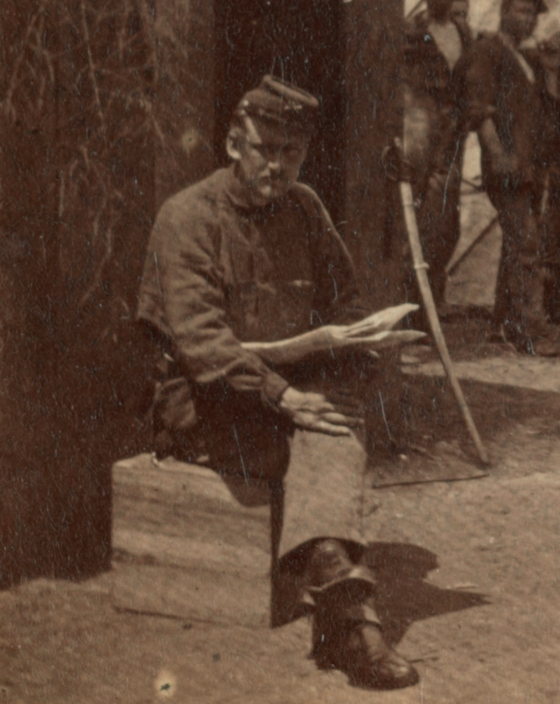Emilie Davis’s Civil War: The Diaries of a Free Black Woman in Philadelphia, 1863-1865 edited by Judith Giesberg. Penn State University Press, 2014. Paper, ISBN: 978-0271063683. $16.95.
 Judith Giesberg’s Emilie Davis’s Civil War: The Diaries of a Free Black Woman in Philadelphia, 1863-1865 offers a unique glimpse at the Civil War home front. Emilie Davis, a free black woman living in Philadelphia during the war, recorded her thoughts about everyday life in three small diaries, currently housed at the Historical Society of Pennsylvania. Giesberg and the members of the Memorable Days Project, a group of graduate students and faculty at Villanova, have brought Emilie’s diaries to life in this monumental volume from Penn State Press.
Judith Giesberg’s Emilie Davis’s Civil War: The Diaries of a Free Black Woman in Philadelphia, 1863-1865 offers a unique glimpse at the Civil War home front. Emilie Davis, a free black woman living in Philadelphia during the war, recorded her thoughts about everyday life in three small diaries, currently housed at the Historical Society of Pennsylvania. Giesberg and the members of the Memorable Days Project, a group of graduate students and faculty at Villanova, have brought Emilie’s diaries to life in this monumental volume from Penn State Press.
Emilie Davis’s diary from 1863 to 1865 does not chronicle the events of a nation at war, but instead details the busy life of a free black woman living in wartime Philadelphia. Giesberg states that Emilie experiences the Civil War as a “grind,” an “unwelcome visitor,” and a “dramatic interruption” (5). A reader of the diary will certainly experience the daily grind of Emilie’s life – centered on attending church and school, visiting with friends and relatives, reading, and sewing – and may perhaps become impatient with Emilie, wondering why she hasn’t written about the events of war. Giesberg welcomes this impatience because, as she states, it will “allow readers to forget what they think they know about the war and to live its memorable days, with Emilie’s pen as their guide” (13). These three diaries, replete with local scandals, health issues, and daily weather reports, capture the true lived experience of the northern home front.
The first section of the book encompasses all of 1863. It begins with a description of the January 1, 1863, celebrations marking the pronouncement of the Emancipation Proclamation. The reader is then thrust headlong into the milieu of wartime Philadelphia. Emilie visits with friends and neighbors, attends weekly classes at the city’s Institute for Colored Youth, and regularly attends services at the Mother Bethel African Methodist Episcopal Church. Giesberg and the Memorable Days Project team provide maps of Emilie’s Philadelphia, demarcating points of interest, as well as a list of important people and institutions mentioned by name in the diary.
The second and third sections follow Emilie through the war. The final dated entry comes on December 31, 1865. For Emilie, it is simply the end of another year; there is no reflection on the year’s events, and no contemplation about what might be in store for 1866. This ending is yet another fitting reminder that in many places during the Civil War, life went on as usual. The war was not all consuming for many Americans—particularly those in the North, whose land was untouched by battle. Rather, Giesberg argues, the war was experienced at an “uneven pace” (5) and was only worth a mention in the diary if it came close to home, as it did in July of 1863 when the Confederate forces marched into Pennsylvania. Thus, readers will come to understand the Civil War as a ghostly specter: reaching onto the page at various points to wreak havoc, but then quickly fading into the background.
The most important contribution of this project is its potential to enrich our understanding of free black communities in the North during the Civil War. Davis’ writings provide a unique perspective on the activities of teachers and students at the Institute for Colored Youth, the proceedings of various African American organizations like the Ladies Union Association, and the complex racial issues surrounding black enlistment in the military. These diaries allow readers to better understand the Civil War years as fitting into a long continuum of racial struggle in the North. One major trend of the recent scholarship on the Civil War and Reconstruction has been to examine racial tensions within the North—to explore both the complicated relationship between abolitionist and anti-slavery politics and the daily racial strife faced by northern free blacks. The extensive yet unobtrusive annotations throughout the diaries provide readers with an abundance of primary source material, from newspaper records to birth, death, and marriage certificates that corroborate Emilie’s writings and offer new avenues for inquiry.
In addition to the wonderful annotations within the book, Giesberg and the Memorable Days Project team have also created a fantastic digital life for Emilie’s writings. By logging on to their website, interested readers can view each page of the diaries in their original form, search the diaries using keywords, and help the Memorable Days Project by providing new primary source information to help identify individuals named in the diary. This book and its digital counterpart are priceless additions to the study of the northern Civil War home front.
Tyler Sperrazza is a graduate student of History and African American Studies at The Pennsylvania State University; his research focuses on theater and popular culture during the Civil War and Reconstruction.

